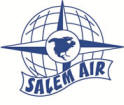|
|
|
|
|
|
||
 |
Classroom Location:
Salem Air Center |
|
| Alphabetical Index of Subjects and Lesson Elements | ||
|
1- Aerodynamics Aerodynamic Terms Axes of Rotation Flaps Forces Acting in Flight Drag Thrust Lift Weight Ground Effect Ground Reference Maneuvers Load Factors Stability Stalls and Spins Turns Wake Turbulence |
||
|
2- Aeronautical Decision Making Preflight Action Single Pilot Resource Management |
||
|
3- Aircraft Systems Aviation Fuel Carburetor Ice Engine Temperatures Fuel Induction Systems Ignition and Electrical Systems Propellers Preflight Inspection Procedures Reciprocating Engines Torque |
||
|
4- Flight Instruments Gyroscopic Instruments - Attitude Indicator - Heading Indicator - Turn Coordinator Magnetic Compass (Northern Hemisphere) Pitot-Static Instruments - Airspeeds and the Airspeed Indicator - Altimeter and Altitudes |
||
|
5- Navigation Equipment Automatic Direction Finder (ADF) Course Determination Global Positioning System (GPS) VHF Omnidirectional Range (VOR) VOR Airways VOR Orientation VOR Receiver Check Points |
||
|
6- Navigation Airspace Calculating Fuel Consumption Dead Reckoning Finding Time, Rate, and Distance Finding True Airspeed and Density Altitude Finding Wind Correction Angle (WCA) and Ground Speed Flight Computer Calculator Face Magnetic Deviation Magnetic Variation Pilotage Pilotage Plotting Courses The Flight Computer (E6-B) Time Topography Wind and Its Effects |
||
|
7- Performance Computing Weight and Balance Problems Using a Graph Computing Weight and Balance Problems Using a Table Cruise Power Setting Table Density Altitude and Aircraft Performance Headwind and Crosswind Component Graph Landing Distance Graphs and Tables Takeoff Distance Weight and Balance |
||
|
8- Physiology Alcohol and Drugs Carbon Monoxide Hyperventilation Hypoxia Oxygen Requirements Spatial Disorientation |
||
|
9- Regulations Acrobatic Flight Airspace Airworthiness Airworthiness Directives (ADs) and Advisory Circulars (ACs) Basic VFR Weather Minimums Categories of Aircraft Change of Address Deviation from Air Traffic Control Instructions Formation Flight and Dropping Objects Glider Towing High-Performance Airplanes Introduction Maintenance and Inspections Medical Certificates Minimum Safe Altitudes National Transportation Safety Board (NTSB) Part 830 Parachutes Pilot Certificate Privileges and Limitations Pilot Ratings Recent Flight Experience Required Certificates Responsibility and Authority of the Pilot-in-Command Right-of-Way Rules Seatbelts Special VFR Weather Minimums Speed Limits VFR Cruising Altitudes VFR Flight Plans |
||
|
10- Weather Air Masses and Fronts Circulation and Wind Clouds Fog Frost Icing Moisture Stability of the Atmosphere Temperature The Heating of the Earth Thunderstorms Turbulence Wind Shear |
||
|
11-Weather Reports and Services Aviation Area Forecast (FA) Aviation Routine Weather Report (METAR) Enroute Flight Advisory Service (EFAS) Inflight Weather Advisories (WA, WS, WST) Low-Level Significant Weather Prognostic Chart Obtaining a Telephone Weather Briefing Pilot Weather Reports (PIREPs) (UA) Radar Weather Reports Terminal Aerodrome Forecast (TAF) Transcribed Weather Broadcast (TWEB) Weather Depiction Chart Winds and Temperatures Aloft Forecast (FD) |
||
